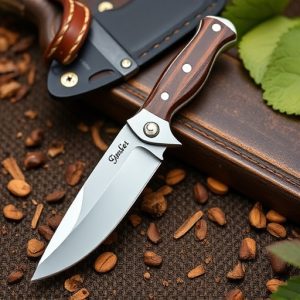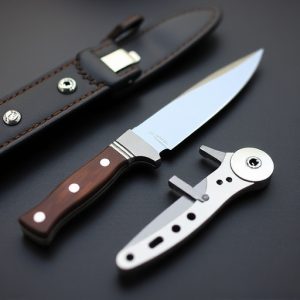Sharpen Your Skills: The Definitive Guide to Fixed Blade Knife Sharpeners
Fixed blade knives require regular sharpening to maintain their performance and safety for various c…….
Fixed blade knives require regular sharpening to maintain their performance and safety for various cutting tasks. The choice of sharpening tool—whether it's a stone, ceramic rod, or electric sharpener—should be based on the knife's steel type, with high-carbon steels needing more frequent, less aggressive honing than stainless steels. Achieving a burr on both sides of the blade is essential for successful resharpening. Potential buyers should consider the necessary sharpening method and tools when purchasing fixed blade knives for sale to keep these tools in optimal condition. It's important to understand edge angles, bevels, and the types of sharpeners available, from traditional oil stones to modern electric sharpeners. Mastery of these aspects ensures that your fixed blade knives will remain sharp, ready for any challenge, and maintain their value when sold or kept for personal use. Regular maintenance and understanding the knife's steel composition are key to extending its lifespan and ensuring it performs safely and effectively.
exploration into the realm of knife maintenance, this article serves as a comprehensive guide to mastering the edge of your fixed blade knives. Whether you’re a seasoned outdoorsman or an amateur chef, maintaining the sharpness and durability of your blades is paramount. We’ll delve into selecting the right sharpener for your collection of fixed blade knives for sale, and uncover the art of sharpening through tried-and-true techniques and essential tools. By understanding maintenance mastery, you can ensure your fixed blades retain their edge longer, enhancing both safety and functionality in various tasks. Join us as we guide you through the process of preserving the life of your knives with practical advice tailored for enthusiasts and professionals alike.
Mastering the Edge: The Ultimate Guide to Fixed Blade Knives for Sale and Their Sharpeners
When it comes to maintaining the integrity and functionality of your fixed blade knives, understanding how to effectively sharpen them is paramount. A well-maintained edge on a fixed blade knife not only ensures safety but also efficacy in various cutting tasks. Whether you’re an outdoors enthusiast, a chef, or someone who values the utility and artistry of a finely crafted blade, the quest for the best fixed blade knives for sale is often accompanied by the need for reliable sharpening tools.
The process of sharpening a fixed blade knife involves selecting the appropriate sharpener, whether it be a stone, a ceramic rod, or an electric sharpener, and applying the correct technique to achieve a razor-sharp edge. The type of steel from which your knife is made will dictate the pace at which you’ll need to maintain its sharpness. High-carbon steels, for instance, are known for their ability to hold an edge but require more frequent honing to prevent dulling. On the other hand, stainless steel blades may be more resistant to corrosion and staining but might need less aggressive sharpening. Regardless of the steel type, the goal is to establish a burr on both sides of the blade, which indicates that the edge has been correctly resharpened.
In your pursuit of fixed blade knives for sale, consider the sharpening method and tools you’ll need to keep these essential items in pristine condition. A comprehensive guide to mastering the edge should cover various angles and bevels, as well as the different types of sharpeners available, from traditional whetstones to modern electronic devices. Understanding the specific needs of your knife’s steel composition will enable you to choose the best approach for maintaining its performance. With the right knowledge and tools, you can ensure that your fixed blade knives remain sharp and ready for any task at hand.
Selecting the Right Sharpener for Your Fixed Blade Knife Collection
When it comes to maintaining the performance and safety of your fixed blade knives, selecting the right sharpener is paramount. Each knife in your collection may require a different type of sharpener based on its steel type, edge angle, and intended use. For high-carbon steel blades that are prone to rusting but hold an edge well, consider a ceramic rod or fine stone for sharpening. Ceramic and diamond sharpeners are excellent choices for their durability and ability to maintain a consistent angle, which is crucial for maintaining the original factory edge. When browsing for fixed blade knives for sale, also look out for sharpeners that come with guides or angles already set, as these can greatly simplify the process, especially for beginners. Additionally, natural oil stones like Arkansas stones are traditional favorites for those who prefer a more hands-on approach to knife maintenance. They provide a gentle sharpening experience and can be used in conjunction with a honing rod to keep your blade aligned before a major resharpening session.
For those with a diverse collection of fixed blade knives, having a variety of sharpeners on hand can ensure that each knife is cared for properly. A combination tool that includes coarse, medium, and fine grinding surfaces can handle the majority of sharpening tasks. This allows you to remove significant nicks or chips with the coarse side before refining the edge to a razor-sharp finish with the finer surfaces. Always remember to match the sharpener’s grit level to the condition of your knife’s edge; starting with a finer grit if the blade is already quite sharp, and moving up to progressively coarser grits as needed. When purchasing fixed blade knives for sale, consider whether the seller also provides a compatible sharpener or recommendation, as this can enhance both the value and the longevity of your knife collection.
The Art of Sharpening: Techniques and Tools for Perfecting Your Fixed Blade's Edge
When it comes to maintaining the performance and safety of your fixed blade knives, mastering the art of sharpening is paramount. Unlike their folding counterparts, fixed blades often require more robust maintenance due to their constant exposure to tasks. The process begins with selecting the right sharpener; options abound from ceramic rods to diamond stones, each offering distinct advantages for different types of edge bevels and knife steels. For instance, ceramic rods are a popular choice for their ability to create a fine edge, suitable for finicky tasks like filleting. They’re also lightweight and easy to transport, making them ideal for outdoor enthusiasts who need to maintain their blades in the field. On the other hand, diamond stones provide an exceptionally durable surface that can resharpen even the hardest steel blades, making them a reliable option for heavy-duty use or professional settings where fixed blade knives for sale are frequently employed and must be kept razor-sharp.
To achieve a perfect edge, one must understand the angles at which they sharpen. The ideal angle can vary depending on the knife’s design and intended use; it’s typically between 15 to 30 degrees for fixed blades. Achieving this angle requires practice and patience. Start with the coarse side of your chosen sharpener to remove significant nicks or dullness, then transition to the fine side to hone the edge to a razor-like sharpness. Always ensure you’re applying consistent pressure and maintaining the correct angle throughout the process to avoid altering the blade’s bevel or creating an uneven edge. Regularly sharpening your fixed blade knives for sale not only prolongs their lifespan but also ensures they perform optimally, whether you’re carving, chopping, or skinning. With the right techniques and tools, anyone can perfect their fixed blade’s edge, transforming a dull blade into an instrument of precision and skill.
Maintenance Mastery: Prolonging the Life of Your Fixed Blade Knives Through Regular Sharpening
The longevity and efficacy of your fixed blade knives are significantly influenced by how well you maintain their edges. Regular sharpening is not just a matter of keeping them sharp for optimal performance; it’s a critical aspect of maintenance mastery that can prolong the life of your blades. When a blade becomes dull, the risk of damage increases with each use as the knife must exert more force to cut through materials. This can lead to chipping or even breaking the edge, rendering the knife unusable. To prevent this, invest in high-quality fixed blade knives for sale that come with recommendations for proper care and sharpening frequency.
Sharpening your fixed blade knives should be approached with both routine and precision. The most effective sharpener for your needs can vary depending on the steel of the blade and its current condition. Ceramic or diamond hones are preferred by many for their ability to restore an edge quickly without removing too much metal. A sharpening stone, often favored by artisans, provides a more manual approach but allows for fine control over the angle and pressure applied to the blade. Regardless of the method chosen, consistency is key. Establish a regular schedule for checking and touching up the edge of your knife. This practice ensures that you’re always prepared for tasks that demand a sharp, reliable tool. By integrating this maintenance mastery into your routine, you’ll not only enhance the longevity of your fixed blade knives for sale but also ensure they remain indispensable companions for all your cutting needs.


